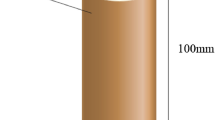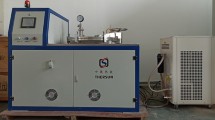Abstract
Microwave-induced fracturing of hard rock can be used to assist mechanical rock breakage and release stress on rock masses in deep underground engineering operations. This is significant to those aiming to improve the construction efficiency and safety of underground tunnelling and ore extraction operations. The research was devoted to exploring the computed tomography (CT) and acoustic emission (AE) characteristics of hard rock subjected to microwave irradiation. For this purpose, microwave irradiation tests at a given power for different irradiation times were conducted on basalt collected from Chifeng, China by utilising a multimode cavity working at a frequency of 2450 MHz. By applying an infrared camera, the temperature distribution on the surface of samples during microwave irradiation was measured. Three-dimensional (3-d) microscopic CT was conducted on samples treated, and not treated, with microwave irradiation to explore the crack propagation regimes in such samples. Based on CT value and P-wave velocities, the damage characteristics of microwave treatment on basalt samples were evaluated. Afterwards, uniaxial compression strength tests were conducted and AE information in the loading process of samples was collected. After conducting microwave irradiation, internal cracks of samples propagated to generate fracture surfaces and surface temperatures of samples were found to have been non-uniformly distributed. The longer the irradiation time, the higher the degree of crack propagation in samples; P-wave velocities both decreased with increasing irradiation duration. With increasing irradiation time, the brittle failure characteristics of basalt shown in the time-dependent change curve of stress on basalt were gradually weakened while ductile failure characteristics were gradually strengthened. The uniaxial compressive strength, corresponding AE energy and cumulative AE energy at peak strength all gradually decreased with increasing irradiation time. The failure stress, the level of stress drop, AE energy, and cumulative AE energy of basalt after different irradiation times reflected consistent fracturing characteristics of basalt, which were interactively validated.











Similar content being viewed by others
References
Ahrens TJ (1995) Mineral physics and crystallography: a handbook of physical constants. American Geophysical Union, Washington
Ali AY, Bradshaw SM (2010) Bonded-particle modelling of microwave-induced damage in ore particles. Miner Eng 23(10):780–790
Bieniawski ZT, Bernede MJ (1979) Suggested methods for determining the uniaxial compressive strength and deformability of rock materials: part 1. Suggested method for determining deformability of rock materials in uniaxial compression. Int J Rock Mech Min Sci Geomech Abstr 16(2):138–140
Charikinya E, Bradshaw S, Becker M (2015) Characterising and quantifying microwave induced damage in coarse sphalerite ore particles. Miner Eng 82:14–24
Feng XT, Chen SL, Zhou H (2004) Real-time computerized tomography (CT) experiments on sandstone damage evolution during triaxial compression with chemical corrosion. Int J Rock Mech Min Sci 41(2):181–192
Haque KE (1999) Microwave energy for mineral treatment processes—a brief review. Int J Miner Process 57(1):1–24
Hassani F, Nekoovaght P (2011) The development of microwave assisted machineries to break hard rocks. In: Proceedings of the 28th international symposium on automation and robotics in construction (ISARC), Seoul, pp 678–684
Hassani F, Nekoovaght PM, Radziszewski P, Waters KE (2011) Microwave assisted mechanical rock breaking. In: Proceedings of the 12th ISRM international congress on rock mechanics. International Society for Rock Mechanics, Beijing, pp 2075–2080
Hassani F, Nekoovaght PM, Gharib N (2016) The influence of microwave irradiation on rocks for microwave-assisted underground excavation. J Rock Mech Geotech Eng 8(1):1–15
Huang S, Xia K (2015) Effect of heat-treatment on the dynamic compressive strength of Longyou sandstone. Eng Geol 191:1–7
Jerby E, Dikhtyar V, Aktushev O, Grosglick U (2002) The microwave drill. Science 298(5593):587–589
Jones DA, Kingman SW, Whittles DN, Lowndes IS (2007) The influence of microwave energy delivery method on strength reduction in ore samples. Chem Eng Process 46(4):291–299
Kingman SW (2006) Recent developments in microwave processing of minerals. Int Mater Rev 51(1):1–12
Kingman SW, Corfielf GM, Rowson NA (1998) Effects of microwave radiation upon the mineralogy and magnetic processing of a massive Norwegian ilmenite ore. Magn Electr Sep 9:131–148
Kingman SW, Vorster W, Rowson NA (2000) The influence of mineralogy on microwave assisted grinding. Miner Eng 13(3):313–327
Li YH, Lu GM, Feng XT, Zhang X (2017) The influence of heating path on the effect of hard rock fragmentation using microwave assisted method. Chin J Rock Mechan Eng 36(6):1460–1468
Lu GM (2018) Experimental study on the microwave fracturing of hard rock. Northeastern University, Shenyang
Lu GM, Li YH, Hassani F, Zhang X (2016) Review of theoretical and experimental studies on mechanical rock fragmentation using microwave-assisted approach. Chin J Geotech Eng 38(8):1497–1506
Lu GM, Li YH, Hassani F, Zhang X (2017) The influence of microwave irradiation on thermal properties of main rock-forming minerals. Appl Therm Eng 112(2):1523–1532
Lu GM, Feng XT, Li YH, Hassani F, Zhang X (2019a) Experimental investigation on the effects of microwave treatment on basalt heating, mechanical strength, and fragmentation. Rock Mech Rock Eng 52(08):2535–2549
Lu GM, Feng XT, Li YH, Zhang X (2019b) The microwave-induced fracturing of hard rock. Rock Mech Rock Eng 52(09):3017–3032
Lu GM, Feng XT, Li YH, Zhang X (2020) The influence of microwave treatment on mechanical behaviour of compact basalts under different confining pressures. J Rock Mech Geotech Eng 12(02):213–222
Makul N, Rattanadecho P, Agrawal DK (2014) Applications of microwave energy in cement and concrete—a review. Renew Sustain Energy Rev 37(3):715–733
Monti T, Tselev A, Udoudo O, Ivanov IN, Dodds C, Kingman SW (2016) High-resolution dielectric characterization of minerals: a step towards understanding the basic interactions between microwaves and rocks. Int J Miner Process 151(10):8–21
Nekoovaght P, Gharib N, Hassani F (2014) Numerical simulation and experimental investigation of the influence of 2.45 GHz microwave radiation on hard rock surface. In: ISRM international symposium—8th Asian rock mechanics. International Society for Rock Mechanics, Sapporo, Japan
Saroglou C, Kallimogiannis V (2017) Fracturing process and effect of fracturing degree on wave velocity of a crystalline rock. J Rock Mech Geotech Eng 9(5):797–806
Tian J, Lu GM, Feng XT, Li YH, Zhang X (2019) Experimental study on the microwave sensitivity of main rock-forming minerals. Rock Soil Mech 40(6):1–9
Toifl M, Hartlieb P, Meisels R, Antretter T, Kuchar F (2017) Numerical study of the influence of irradiation parameters on the microwave-induced stresses in granite. Miner Eng 103–104(4):78–92
Wang YC, Djordjevic N (2014) Thermal stress FEM analysis of rock with microwave energy. Int J Miner Process 130:74–81
Whittles DN, Kingman SW, Reddish DJ (2003) Application of numerical modelling for prediction of the influence of power density on microwave-assisted breakage. Int J Miner Process 68(1):71–91
Xia K, Yao W (2015) Dynamic rock tests using split Hopkinson (Kolsky) bar system—a review. J Rock Mech Geotech Eng 7(1):27–59
Yan CZ, Zheng H (2017) A coupled thermo-mechanical model based on the combined finite-discrete element method for simulating thermal cracking of rock. Int J Rock Mech Min Sci 91:170–178
Yao W, Xia K, Liu HW (2018) Influence of heating on the dynamic tensile strength of two mortars: experiments and models. Int J Impact Eng 122:407–418
Zhang Y, Feng XT, Yang CX, Zhang X, Sharifzadeh M, Wang ZF (2019) Fracturing evolution analysis of Beishan granite under true triaxial compression based on acoustic emission and strain energy. Int J Rock Mech Min Sci 117:150–161
Zhao J, Feng XT, Zhang X, Zhang Y, Zhou YY, Yang CX (2018) Brittle–ductile transition and failure mechanism of Jinping marble under true triaxial compression. Eng Geol 232:160–170
Zheng YL, Zhang QB, Zhao J (2017) Effect of microwave treatment on thermal and ultrasonic properties of gabbro. Appl Therm Eng 127:359–369
Acknowledgements
Financial support for this work by the National Natural Science Foundation of China (No: 41827806), by the Science and Technology Research and Development Plan of China Railway Group Limited (No: 2020-Zhongda-06) and the Science and Technology Innovation Plan of China Railway Tunnel Group (No: Suiyanhe 2020-11) are greatly appreciated.
Author information
Authors and Affiliations
Corresponding author
Ethics declarations
Conflict of interest
The authors wish to confirm that there are no known conflicts of interest associated with this manuscript.
Additional information
Publisher's Note
Springer Nature remains neutral with regard to jurisdictional claims in published maps and institutional affiliations.
Rights and permissions
About this article
Cite this article
Lu, G., Sun, Z., Zhou, J. et al. Effect of Microwave Irradiation on Computed Tomography and Acoustic Emission Characteristics of Hard Rock. Geotech Geol Eng 39, 411–424 (2021). https://doi.org/10.1007/s10706-020-01500-5
Received:
Accepted:
Published:
Issue Date:
DOI: https://doi.org/10.1007/s10706-020-01500-5




